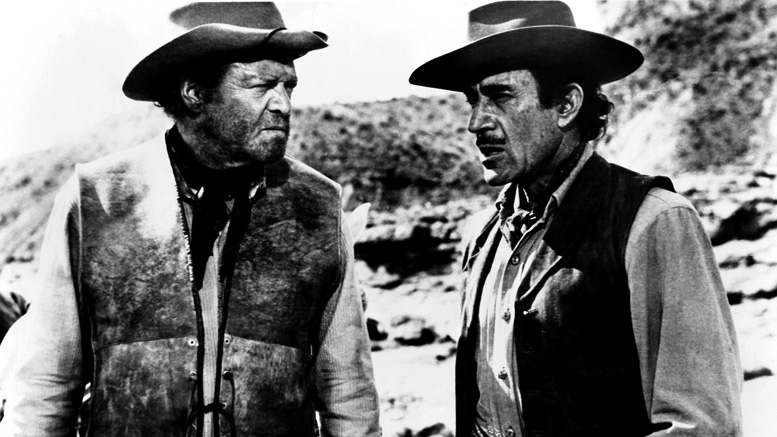
Cast: Bella Cortez (Lota), Rod Flash [Iloosh Khoshabe] (Ali Baba), Furio Meniconi (Mustafa), Amedeo Trilli (Hassam Bay, Loto’s father), Salvatore Furnari, Omero Gargano, Aristide Massari, Mario Polentin, Yvonne Sirè, Liliana Zagra, Mario Bacarti, Giovanni Silvagni, Caridad Fuentes, Franco Jamonte, Liliana Palazio, Giuseppe Trinca, Giovanni Silvagni, Renato Terra, Renzo Stefinlongo, Ivo Occhicupi
Although Vulcan Son of Jupiter wasn’t a huge success, it did prove popular – and profitable – enough for Salvi to return to similar territory with The Seven Tasks of Ali Baba. Both films take their inspiration from familiar myths and legends, in this case Arabian folk stories rather than Roman mythology. The plots, though, bear only a minimal resemblance to their source material, and here the familiar tale from One Thousand and One Nights is supplanted by the more traditional dynastic and romantic ingredients that were found in just about every peplum being made at the time.
Ali Baba (Rod Flash), a legendary hero who lives in the famed city of Sesame, is summoned by a mysterious old genie with a task for him: to transport a sacred crown to a man called Hassam Bey (Amedeo Trilli). Hassam is the rightful ruler of an Arab land which has been conquered by a cruel and overbearing tyrant, Mustafa (Furio Meniconi), and he’s agreed to give him the crown in exchange for the guaranteed safety of his people. Mustafa, however, also has his eye on Hassam’s unwilling daughter, Loto (Bella Cortez), who he wants to marry in order to bring some kind of authority to his unpopular regime… and the fact that she’s a rather attractive young lady doesn’t make it any less inviting a proposition.
Sinbad, meanwhile, has heard about Mustafa’s wicked ways and has decided that, rather than fulfilling his original mission, he should do everything in his power to help kick him out. Unfortunately, when he refuses to hand over the crown – which he’s had the foresight to hide during his journey – he’s immediately taken prisoner and subjected to a series of protracted, not to mention overcomplicated, tortures. Unsurprisingly, none of them work and, with a little help from Loto, he’s able to escape. After hooking up with his back-up squad of forty thieves, he sets about fostering a rebellion to oust the despot. Mustafa, however, is nobody’s fool, and determines to put down any resistance with all force necessary.
This is a more earthbound concoction than Vulcan, Son of Jupiter and, apart from the rather underwhelming genie and a bit of ghostly nonsense in some underground caverns, it very much plays down the supernatural and fantastical elements. Apart from that, the two films aren’t too different – hey, if you have a formula that works, why change it – something that’s perhaps unsurprising given they were both written by the same core team of Salvi, Ambrogio Molteni and Benito Ilforte. The lack of rubbery monsters and bickering deities does make it a little less leftfield, but Salvi seems to have stepped up the action in order to compensate, throwing in a few reasonably constructed fights and even a moderately ambitious battle sequence instead. In a way, though, it feels like Salvi has watered down his eccentricities a bit, delivering a product that’s more professionally constructed but not quite as idiosyncratic, which is a bit of a shame.
The supposedly Arabian setting, however, makes for a pleasant change, even though it looks like a strangely Italian Arabia. It’s pretty obvious to all but the most naïve of viewers that most of it was filmed on the Cinecitta stage-sets and, as with Vulcan, it has a strangely stagey feel. There’s a greater use of exteriors, though, most of which were shot in the environs of Rome and look remarkably verdant, despite the presence of a palm tree which I’m sure must have been shipped around and plonked in the background of just about every location. Perhaps this studio-based aspect links in to two of the films great strengths: some great art direction by Giovanni Amidei and some fabulous choreography, including an astounding dance sequence featuring Bella Cortez, some giant swings and some strapping lads in tight, pink leotards.
Several cast members had also been in Vulcan Son of Jupiter. Iranian Rod Flash is a bit more animated this time, and his looks certainly fit the role, but nobody could argue that he was a great actor. Other returnees include irritating comedy midget Omero Gargano – who even gets carried around while dressed as a baby in this one – Furio Meniconi, Salvatore Furnari and Amedeo Trilli. Bella Cortez is pretty good in this, playing Loto as a somewhat sulky teen and, as mentioned, displaying some of her better dance moves.
The Seven Tasks of Ali Baba proved, like its predecessor, moderately successful, taking roughly 250 million lire in Italy (Vulcan took 276 million). That represented pretty good receipts for production company Avis Film, who specialised in low-budget, low-prospect releases (their portfolio also included Gastone Grandi’s almost legendary 24 ore di terrore (64), Massimo Pupillo’s terrible western Bill il taciturno (67) and an oddity starring Beverley Garland (Salome ’73)). Salvi was happy enough with the results to direct a kind of semi-seuquel, Ali Baba and the Seven Saracens in 1964, which was marketed as a follow-up internationally, even though the protagonist was actually called ‘Sinbad’ in the Italian version.
|
|
|
|




Hi Matt,
Do you know where I can purchase an English version of, “The Seven Tasks of Ali Baba.”
Thank you!
Blake